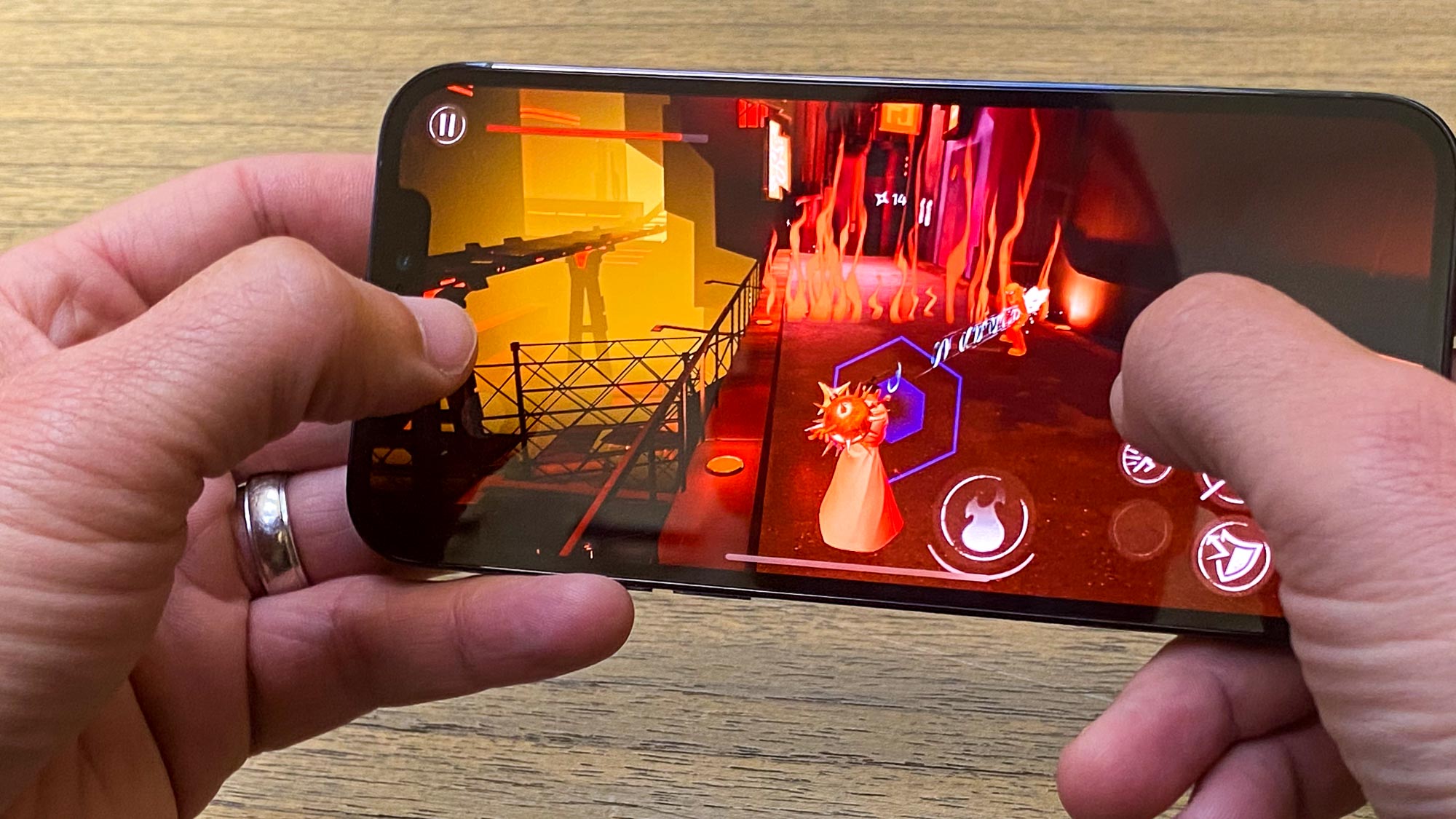iPhone 12 benchmark results — Android phones should just give up now
Powered by an A14 Bionic processor, the iPhone 12 and iPhone 12 Pro are the fastest phones yet

Apple promised big performance gains from the A14 Bionic processor that powers the latest iPhone 12 models. And based on our testing of both the iPhone 12 and iPhone 12 Pro, the company wasn't kidding about what the A14 can do. In fact, the iPhone 12 series once again leaves the best Android phones in the dust.
In both synthetic benchmarks and real-world tests, the new 5nm A14 chip beat every Android phone out there. This means that the gap between the iPhone 12 and the competition has widened again, at least until Qualcomm can answer with its Snapdragon 875 chip.
- iPhone 12 Pro review: A big leap forward
- See our iPhone 12 review
- Just in: iPhone 12 MagSafe charging speed revealed — and it's bad news
Apple told us this would happen. When it announced its new iPhones this month, it promised a 50% jump in performance and graphics, among other improvements. We haven't seen those kind of gains when comparing the iPhone 12 and iPhone 12 Pro to some more recent models, but the latest iPhones certainly outperform their predecessors.
Measuring a phone's performance involves more than just raw numbers. The folks testing these phones for our iPhone 12 and iPhone 12 Pro reviews report that the new phones have handled anything they can throw at it, including some very demanding games. Still, benchmarks help us illustrate those impressions of a faster, more responsive phone.
Here's what we've recorded for the iPhone 12 and iPhone 12 Pro so far.
iPhone 12: Geekbench 5 results
Geekbench 5 measures general performance. It's a test the iPhone usually dominates, and that's continuing with the iPhone 12.
| Phone | Processor | Geekbench 5 single-core result | Geekbench 5 multicore result |
| iPhone 12 | A14 Bionic | 1,593 | 3,859 |
| iPhone 12 Pro | A14 Bionic | 1,595 | 3,880 |
| iPhone 11 Pro Max | A13 Bionic | 1,334 | 3,517 |
| Samsung Galaxy Note 20 Ultra | Snapdragon 865 Plus | 985 | 3,294 |
| Samsung Galaxy S20 Plus | Snapdragon 865 | 811 | 3,076 |
| OnePlus 8T | Snapdragon 865 | 887 | 3,203 |
| ROG Phone 3 | Snapdragon 865 Plus | 974 | 3,393 |
| Google Pixel 5 | Snapdragon 765G | 596 | 1,617 |
The iPhone 12 posts the best numbers in Geekbench 5, with a single core score of 1,593 and a multicore score of 3,859. Those are improvements 19% and 10%, respectively, over the iPhone 11 Pro Max's single-core and multicore results in the same test. The iPhone 12 Pro's best results topped the iPhone 12, with scores of 1,595 and 3,880.
Sign up to get the BEST of Tom's Guide direct to your inbox.
Get instant access to breaking news, the hottest reviews, great deals and helpful tips.
More importantly, both iPhones beat out all of the recent Android devices we've tested. The ROG Phone 3 from Asus had the best results in Geekbench, thanks to its Snapdragon 865 Plus chipset, an overclocked version of the standard 865. But the ROG Phone 3's single core and multicore scores of 974 and 3,3393 are well behind what you see from the iPhone 12 models. Other Android flagships like the Galaxy Note 20 Ultra and Galaxy S20 Plus also lag behind.
iPhone 12: Graphics benchmark
For graphics, we used 3DMark's new Wild Life test, a new cross-platform benchmark meant to compare graphics performance on new handsets. This benchmark has phones render complex scenes in real-time, as it looks to mirror games that feature short bursts of intense activity.
| Phone | Processor | 3DMark Wild Life score | 3DMark Wild Life frames per second |
| iPhone 12 | A14 Bionic | 6,562 | 39 |
| iPhone 12 Pro | A14 Bionic | 6,567 | 39 |
| iPhone 11 Pro Max | A13 Bionic | 7,709 | 42 |
| Samsung Galaxy Note 20 Ultra | Snapdragon 865 Plus | 4,164 | 25 |
| Samsung Galaxy S20 Plus | Snapdragon 865 | 3,809 | 23 |
| OnePlus 8T | Snapdragon 865 | 3,772 | 23 |
| Google Pixel 5 | Snapdragon 765G | 1,138 | 7 |
We ran into a surprise with this test where the iPhone 11 Pro Max actually posted a better result than the new iPhones, averaging a score of 7,709 or 42 frames per second. The iPhone 12 and iPhone 12 Pro turned in similar results to each other at 6,562 and 6,567, respectively. That translates to 39 fps.
While we puzzle why the older iPhone fared better on this particular benchmark, it's worth noting that the Android phones we've tested so far with 3DMark Wild Life finish well behind the iPhone 12. The best result we've gotten as we retest recently released phones comes from the Samsung Galaxy Note 20 Ultra, which turned in a result of 4,182 (25 FPS). The iPhone 12 Pro's result is 57% better.
| Phone | Processor | 3DMark Wild Life Unlimited score | 3DMark Wild Life frames per second |
| iPhone 12 | A14 Bionic | 8,555 | 51 |
| iPhone 12 Pro | A14 Bionic | 8,619 | 51 |
| iPhone 11 Pro Max | A13 Bionic | 7,951 | 42 |
| Samsung Galaxy Note 20 Ultra | Snapdragon 865 Plus | 4,182 | 25 |
| Samsung Galaxy S20 Plus | Snapdragon 865 | 3,814 | 23 |
| OnePlus 8T | Snapdragon 865 | 3,750 | 22.5 |
| Google Pixel 5 | Snapdragon 765G | 1,160 | 7 |
There's also an Unlimited version of the Wild Life benchmark that runs the testing off-screen. Here, things went as expected, with the iPhone 12 Pro posting the best numbers and both new iPhones outperforming the iPhone 11 Pro Max. As you might expect, the iPhones left the Android devices we tested in the dust on Wild Life Unlimited.
iPhone 12: Video encoding results
A real-world test we like to run on premium phones involves the Adobe’s Premiere Rush app. In this test, we time how long it takes for a phone to transcode a short 4K video to 1080p. The iPhone usually excels on this test, though recent Android phones have improved. They're going to have to become even more powerful if they want to catch the iPhone 12, though.
| Phone | Processor | Adobe Premiere Rush encoding time (Mins:Secs) |
| iPhone 12 | A14 Bionic | 0:26 |
| iPhone 12 Pro | A14 Bionic | 0:27 |
| iPhone 11 Pro Max | A13 Bionic | 0:45 |
| Samsung Galaxy Note 20 Ultra | Snapdragon 865 Plus | 1:16 |
| Samsung Galaxy S20 Plus | Snapdragon 865 | 1:13 |
| OnePlus 8T | Snapdragon 865 | 1:38 |
| ROG Phone 3 | Snapdragon 865 Plus | 1:35 |
| Google Pixel 5 | Snapdragon 765G | 2:52 |
The iPhone 12 Pro took care of our video in 27 seconds, while the iPhone 12 shaved a second off that time. That's an impressive improvement over the iPhone 11 Pro Max's previously pace-setting time of 46 seconds.
The best an Android phone has mustered in our video encoding test has been the 1 minute and 13 second time that the Galaxy S20 Plus turned in earlier this year, though the Note 20 Ultra finished three seconds behind that. It takes the OnePlus 8T and ROG Phone 3 more than 90 seconds to do something the iPhone 12 completes in less than half-a-minute.
iPhone 12 performance outlook
There's plenty to consider when buying a new smartphone, from battery life to how well the cameras measure up. But if you're wondering abut performance, you can be confident that the iPhone 12 and its A14 processor will be up to any task. It's time for Android phones to play catchup — again.
Philip Michaels is a Managing Editor at Tom's Guide. He's been covering personal technology since 1999 and was in the building when Steve Jobs showed off the iPhone for the first time. He's been evaluating smartphones since that first iPhone debuted in 2007, and he's been following phone carriers and smartphone plans since 2015. He has strong opinions about Apple, the Oakland Athletics, old movies and proper butchery techniques. Follow him at @PhilipMichaels.
-
donth8 Great article Philip! Could you please run the Wild Life Stress Test to see if the A14 improves on sustained performance compared to the A13? That was the Achilles heal for the A13 getting only 51% of the frame rate after 20 runs. No one has run that yet online would be a game changer.Reply
Thank you! -
Godofbiscuits To be fair, Apple said that the new iPad Air was 50% faster than the previous iPad Air. It didn’t say the A14 was 50% faster than the A13.Reply -
TheW8YM8KER Replydonth8 said:Great article Philip! Could you please run the Wild Life Stress Test to see if the A14 improves on sustained performance compared to the A13? That was the Achilles heal for the A13 getting only 51% of the frame rate after 20 runs. No one has run that yet online would be a game changer.
Thank you!
Here’s the issue though - even the iPhone XR losing half of its performance after twenty runs- it still bested the androids -which lost one ( one of the Xr’s lowest scores was beat by just one of the androids highest scores)...
The real issue I have with the wild life stress test is you’re not going to see these kind of drops anyways in real life since games are not pushing any handheld devices to the limits this benchmark is on a completely continuous punishing full throttle full screen aspect.
Most should keep in mind many benchmarks test either the cpu or gpu a bit more the the other.
But Developers tend to balance cpu/gpu usage in games more then most benchmarks like this which also keeps the SOC running cooler then say a benchmark - which in this case- wild life measures and stresses the gpu alone.
Beyond that developers adjust many things and even small things like drawing distance in have a measurable effect on cpu/gpu utilization which lets them give the best combination of performance and battery life. -
techconc FWIW, I'm getting higher Geekbench 5 scores on my iPhone 12 Pro.Reply
Singe core: 1602
Multi-core: 4133 -
Theonlyeyes Reply
No one is surprised. Apple make masterpieces about software and hardware. They push the limit forward looking to do the best. All the brands with android are in the dust and consider that many of them cheat on benchemark test, thanks to software that recognizes when is under test trying to falsificate it. So great Apple to be different and to do the best. The real innovation is made by Apple.admin said:Powered by an A14 Bionic processor, the iPhone 12 and iPhone 12 Pro are the fastest phones yet.
iPhone 12 benchmarks — this destroys every Android phone : Read more

